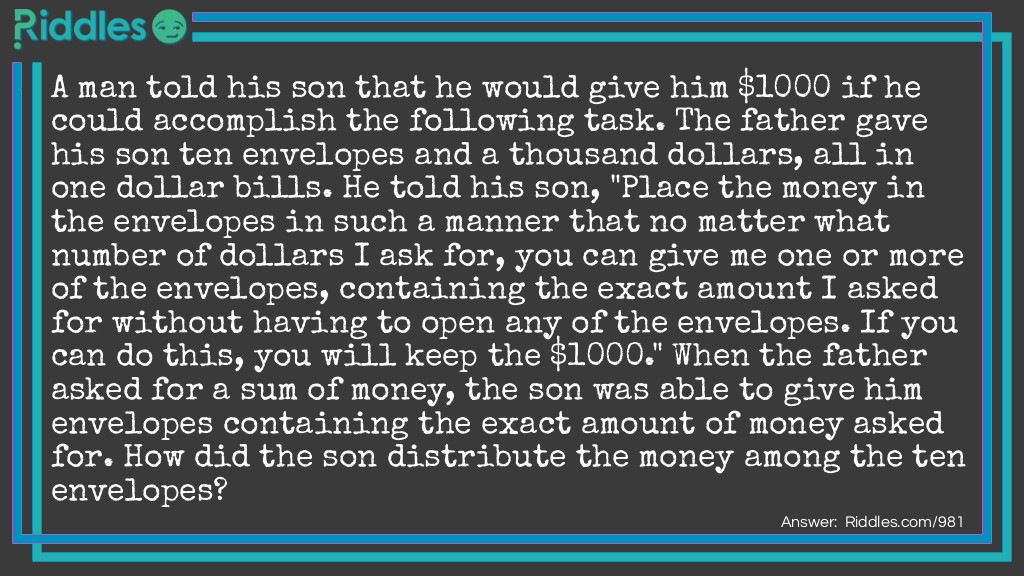1000 Bucks
Riddle: A man told his son that he would give him $1000 if he could accomplish the following task. The father gave his son ten envelopes and a thousand dollars, all in one dollar bills. He told his son, "Place the money in the envelopes in such a manner that no matter what number of dollars I ask for, you can give me one or more of the envelopes, containing the exact amount I asked for without having to open any of the envelopes. If you can do this, you will keep the $1000." When the father asked for a sum of money, the son was able to give him envelopes containing the exact amount of money asked for. How did the son distribute the money among the ten envelopes?
Answer: The contents or the ten envelopes (in dollar bills) should be as follows: $1, $2, $4, $8, $16, $32, $64, $128, $256, $489. The first nine numbers are in geometrical progression, and their sum, deducted from $1,000, gives the contents of the tenth envelope.
Answer explained: The son distributed $1000 into ten envelopes using a clever binary-like approach to ensure he could provide any exact amount from $1 to $1000 by handing over a combination of envelopes without opening them. The first nine envelopes contain amounts that are powers of 2: $1, $2, $4, $8, $16, $32, $64, $128, and $256$, which total $511. The tenth envelope holds the remaining $489 ($1000 - $511$).This setup works because the first nine envelopes can form any amount up to $511 through unique combinations, much like binary numbers. For amounts between $489 and $1000, the son uses the $489 envelope plus a combination of the first nine envelopes to cover the difference—for example, $512 = $489 + $23$, where $23 is made from $16 + $4 + $2 + $1$. This ensures every possible amount from $1 to $1000 can be achieved with a unique combination of envelopes. Source: https://www.riddles.com/981
Answer explained: The son distributed $1000 into ten envelopes using a clever binary-like approach to ensure he could provide any exact amount from $1 to $1000 by handing over a combination of envelopes without opening them. The first nine envelopes contain amounts that are powers of 2: $1, $2, $4, $8, $16, $32, $64, $128, and $256$, which total $511. The tenth envelope holds the remaining $489 ($1000 - $511$).This setup works because the first nine envelopes can form any amount up to $511 through unique combinations, much like binary numbers. For amounts between $489 and $1000, the son uses the $489 envelope plus a combination of the first nine envelopes to cover the difference—for example, $512 = $489 + $23$, where $23 is made from $16 + $4 + $2 + $1$. This ensures every possible amount from $1 to $1000 can be achieved with a unique combination of envelopes. Source: https://www.riddles.com/981

